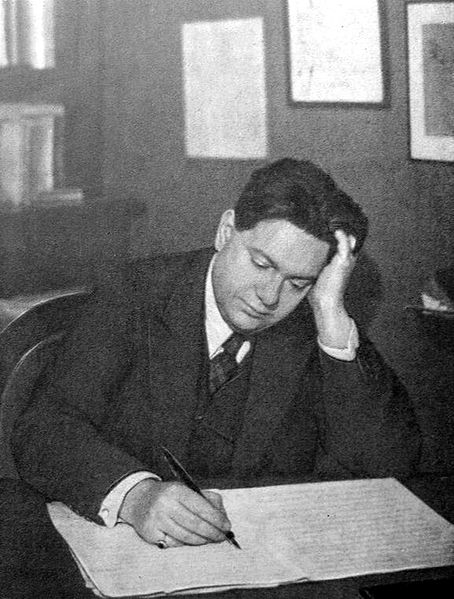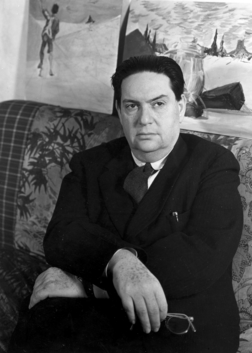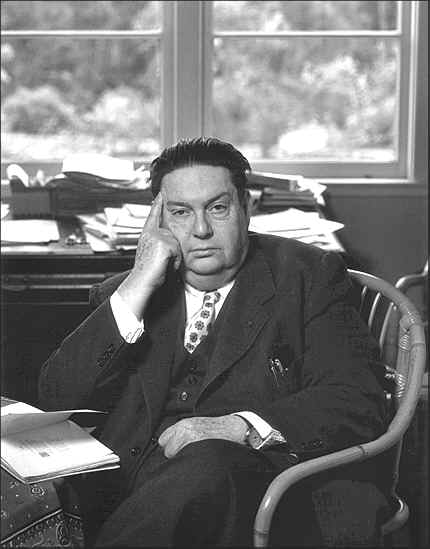<Back to Index>
- Composer Darius Milhaud, 1892
PAGE SPONSOR



Darius Milhaud (4 September 1892 – 22 June 1974) was a French composer and teacher. He was a member of Les Six — also known as The Group of Six — and one of the most prolific composers of the 20th century. His compositions are influenced by jazz and make use of polytonality (music in more than one key at once). Darius Milhaud is to be counted among the modernist composers.
Born in Marseilles to a Jewish family from Aix - en - Provence, Milhaud studied in Paris at the Paris Conservatory where he met his fellow group members Arthur Honegger and Germaine Tailleferre. He studied composition under Charles Widor and harmony and counterpoint with André Gedalge. He also studied privately with Vincent d'Indy. As a young man he worked for a while in the diplomatic entourage of Paul Claudel, the eminent poet and dramatist, who was serving as French ambassador to Brazil.
On a trip to the United States in 1922, Darius Milhaud heard "authentic" jazz for the first time, on the streets of Harlem, which left a great impact on his musical outlook. The following year, he completed his composition "La création du monde" ("The Creation of the World"), using ideas and idioms from jazz, cast as a ballet in six continuous dance scenes.
In 1925, Milhaud married his cousin, Madeleine (1902 – 2008), an actress and reciter. In 1930 she bore him a son, the painter and sculptor Daniel Milhaud, to be the couple's only child.
The rise of Nazism forced the Milhauds to leave France in 1939, and then emigrate to America in 1940 (his Jewish background made it impossible for Milhaud to return to his native country until after its Liberation). He secured a teaching post at Mills College in Oakland, California, where he collaborated with Henri Temianka and the Paganini Quartet. In an extraordinary concert there in 1949, the Budapest Quartet performed the composer's 14th String Quartet, followed by the Paganini's performance of his 15th; and then both ensembles played the two pieces together as an octet. The following year, these same pieces were performed at the Aspen Music Festival in Colorado, by the Paganini and Juilliard Quartet.
The jazz pianist Dave Brubeck became one of Milhaud's most famous students when Brubeck furthered his music studies at Mills College in the late 1940s (he named his eldest son Darius). In a February 2010 interview with Jazzwax, Brubeck said he attended Mills, a women's college (men were allowed in graduate programs), specifically to study with Milhaud, saying "Milhaud was an enormously gifted classical composer and teacher who loved jazz and incorporated it into his work. My older brother Howard was his assistant and had taken all of his classes."
Milhaud's former students also include popular songwriter Burt Bacharach. Milhaud told Bacharach, "Don't be afraid of writing something people can remember and whistle. Don't ever feel discomfited by a melody".
Milhaud (like his contemporaries Paul Hindemith, Gian Francesco Malipiero, Alan Hovhaness, Bohuslav Martinů and Heitor Villa - Lobos) was an extremely rapid creator, for whom the art of writing music seemed almost as natural as breathing. His most popular works include Le bœuf sur le toit (a ballet which lent its name to the legendary cabaret frequented by Milhaud and other members of Les Six), La création du monde (a ballet for small orchestra with solo saxophone, influenced by jazz), Scaramouche (for Saxophone and Piano, also for two pianos), and Saudades do Brasil (dance suite). His autobiography is titled Notes sans musique (Notes Without Music), later revised as Ma vie heureuse (My Happy Life).
From 1947 to 1971 he taught alternate years at Mills and the Paris Conservatoire,
until poor health, which caused him to use a wheelchair during his
later years (beginning sometime before 1947), compelled him to retire.
He died in Geneva, aged 81.
Darius Milhaud was very prolific and composed for a wide range of genres. His opus list ended at 443.